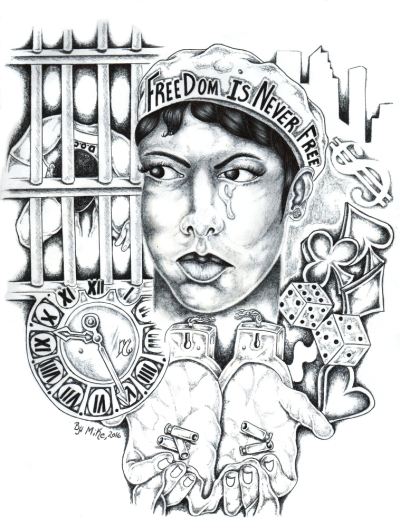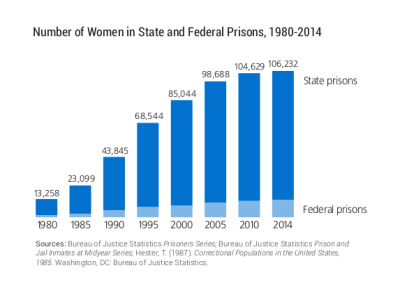
Political Activism in Prisons for Wimmin

In this issue of Under Lock & Key MIM(Prisons) set out to report on revolutionary organizing in wimmin’s prisons in the United $tates.(1) Self-determination for the internal semi-colonies won’t be won by males alone, and yet our subscriber list is overwhelmingly male. As a prison organizing group, we wanted to look at what is our role in resolving contradictions along gender lines, in our struggle toward national liberation and an end to Amerikkkan imperialism. The lumpen class has a strong training in male chauvinism, and prisons are an even more extremely masculine environment. If we are going to contribute to the resolution of gender contradictions, we need to consciously put effort into it.
We solicited articles from many current and former prisoners on this topic, but in the end we received very little response. This coincides with our overall reach into wimmin’s prisons: while about 7% of the population in prison is locked up in wimmin’s prisons, we do not have close to 7% of our subscribers located in these institutions. In this article we will explore the current state of imprisonment of females and some potential reasons for our limited reach and lower political involvement in institutions for wimmin.
MIM(Prisons) has long talked about gender oppression faced by prisoners in the United $tates. Gender is distinct from class and nation, and located within leisure time activities. Usually gender oppression is something suffered by biological females. But in prison, where the vast majority of the population is male, we still see significant gender oppression. When male prisoners are sexually assaulted by guards this is obviously gender oppression because it’s based in “leisure” time. But there are other aspects of this gender oppression, including the Amerikan legacy of lynching New Afrikan men for supposedly raping white wimmin, which is an example of white females having gender power over New Afrikan males. So it’s not so straightforward as just looking at biology to determine who is gender oppressed. And as on the streets, gender interacts with nation to complicate the situation in prisons.

Females make up 18.4% of all people under supervision of the adult correctional system (prison, jail and probation).(2) They are 6.7% of federal prisoners(3) and 7.2% of state prisoners.(2) The higher percentage of females in jails and on probation reflects the lesser severity and shorter sentences compared to males. Because our reach is mainly in prisons, that is what we will focus on here.
Many have commented on the dramatically increasing female prison population in the United $tates, especially as the recent growth rate was so much higher than the rate for males. Between 1995 and 2005 the number of male prisoners grew 34% while the number of female prisoners grew 57%.(4) Overall, females went from 11% of all arrests in 1970 to 26% in 2014.(5) However, the U.$. prison population peaked in 2009 and has been dropping slowly since then. The total change between 2004 and 2014 was a 1% drop in prison population. Over that same period the male prison population dropped 1.2% while the female prison population increased 1.4%. Since 2004 the number of females in prison has bounced up and down every few years with a peak in 2008, a drop from 2008-2012 and then an increase in 2013 and 2014. The dramatic increases in incarcerated females prior to 2004 seem to have leveled off, and there are no clear trends since 2004.(2)
What we can conclude from the numbers above is that the imprisonment rate for females is growing faster than the rate for males, but the growth is relatively slow in recent years and the overall number of females in prison is so much smaller than the number of males that it would take many many years of significant growth to get close to equal incarceration rates between males and females. It is still true that when we talk about prisons in the United $tates we are overwhelmingly talking about prisons for men.
New Afrikans and Chicanas are disproportionately locked up compared to white females (twice the rate for New Afrikans and 1.2 times for Chicanas). But these statistics mean that a much larger proportion of people in female prisons are white than in the male prisons which locks up New Afrikans at almost 6 times the rate of white males and Chicanos at more than twice the rate of whites.(6) And in female prisons the disparity has been decreasing in recent years with incarceration of white females increasing at a faster pace than other nationalities.
Below we examine two possible explanations for MIM(Prisons)’s limited reach into facilities for wimmin. 1. We are not doing a good job addressing issues that are important to this population and so they’re just not interested in working with us. 2. Females in prison are less political than males in prison. If the former is true, we hope that this ULK will inspire readers to write to us and tell us what we’re missing. We do, however, see some solid evidence that the explanation is the lack of political interest among female prisoners.
We need to consider what might cause female prisoners to be less interested in our work than their male counterparts. Those who do write to us often comment on the complete lack of interest among their fellow prisoners. And while we hear this plenty from men’s institutions, we also hear many more stories from the men’s prisons about activism and interest. In addition, some of the wimmin who write to us are transgender and held in male institutions, with this experience contributing greatly to their political awareness.
Based on our experience and what evidence we can find from studies of prisoners, we believe that wimmin are less likely to be locked up long term, less likely to be put in solitary confinement, more likely to have family waiting for them on the outside, and less likely to have been active members of a lumpen organization prior to or during their term. These are mostly conditions of wimmin in general in the United $tates, and so reasonable assumptions to make. We are by no means suggesting that imprisonment of females in this country is free of abuse or anything other than a product of a system built for social control. But females who are swept up in the net of widespread incarceration are often not the primary targets of the system. The stats on nationality make this clear.
One might argue that gender oppression in wimmin’s facilities is scaring people locked up there into unwillingness to reach out to MIM(Prisons). However, we see that increased repression in men’s prisons generally results in increased political interest. We get many letters describing threats resulting from political activism or even just education leading people to greater interest in men’s facilities. And historically, on a global scale, greater oppression has led to greater resistance, by nation, class and gender.
Overall we think the lower percentage of people in wimmin’s facilities reaching out and getting involved with MIM(Prisons) validates our theory about what leads prisoners to becoming politicized. Significant factors include: solitary confinement, lumpen organization involvement, significant repression, censorship and conditions of abuse. Essentially, repression breeds resistance (as long as the repression isn’t so extreme that prisoners face total censorship, or health conditions so bad that they are unable to function). We regularly hear that widespread access to TV and other privileges really does buy prisoners out of political interest and activism. This is not a surprise in a country of wealth and privilege where the vast majority of the population enjoys petty bourgeois lifestyles.
Further supporting this theory is our anecdotal experience that trans wimmin are interested and active behind bars. We know they face significant repression distinct from the general prison population. So it is not surprising that trans prisoners are driven to political awareness and activism.
Unique Challenges in Wimmin’s Prisons
While material conditions, as analyzed above, play a role in the appeal of proletarian-led communist revolution to any population, we also need to look at our own attempts, or lack of, to organize with this population. MIM(Prisons) has not made a concerted effort to connect the struggle for national self-determination with struggles in wimmin’s prisons. With this ULK we hope to spark that conversation.
With that said, we need to look at what unique challenges are faced by people locked up in facilities for wimmin. This will help determine if we are not addressing the issues that are important to these prisoners.
The battle to maintain or regain custody of children is one issue more prevalent in facilities for female prisoners. In 2006 (and other studies suggest this number is pretty constant in recent years), more than 65% of females in state prisons and 55% of males in state prisons had children under 18 years of age. 64% of these mothers lived with their children before prison, compared to 44% of fathers.(7) While this is a pretty big difference, the overall magnitude of the impact of imprisonment isn’t close: there are so many more fathers in prison than mothers in prison. One possibility is that mothers who fear losing custody will do anything they can to keep clean and get out quickly, and this focuses them more on doing their time quietly than fighting abuse.
Sexual assault is another potential issue that may affect female prisoners more than males. In a PREA survey of former prisoners from 2008, 10.5% of females reported prisoner-on-prisoner sexual assaults compared to 2.7% of males. Staff-on-prisoner sexual assault was also more commonly reported by females (2.5%) compared to males (1.1%).(8) We are skeptical of these numbers, especially since the taboo against reporting sexual assault is even greater for males and so it’s hard to say if these statistics represent a meaningful difference between the experiences in wimmin’s and men’s prisons. Even if it does, we wouldn’t expect this abuse to lead females away from political activism. But it is perhaps an issue we need to expose more often to address the large portion of wimmin who are facing this abuse.
The Path Forward
It is important to connect our political line with our strategy and tactics, and engage in the scientific process of developing that line as we learn from our practice. While in this article we have focused on facilities for wimmin and organizing of females behind bars, this is a bigger question of how we mobilize females on the streets to join our revolutionary struggle. We are fighting against class, nation and gender oppression on a global scale, and this battle requires uniting all who can be united. Around the world we have examples of wimmin joining struggles for national liberation, taking up leadership in communist organizations, and historically in leadership positions in Communist China. While we see the national liberation struggle as principal at this point in history, we can not neglect the gender contradiction, both in the general fight against imperialism and in our own political practice.








